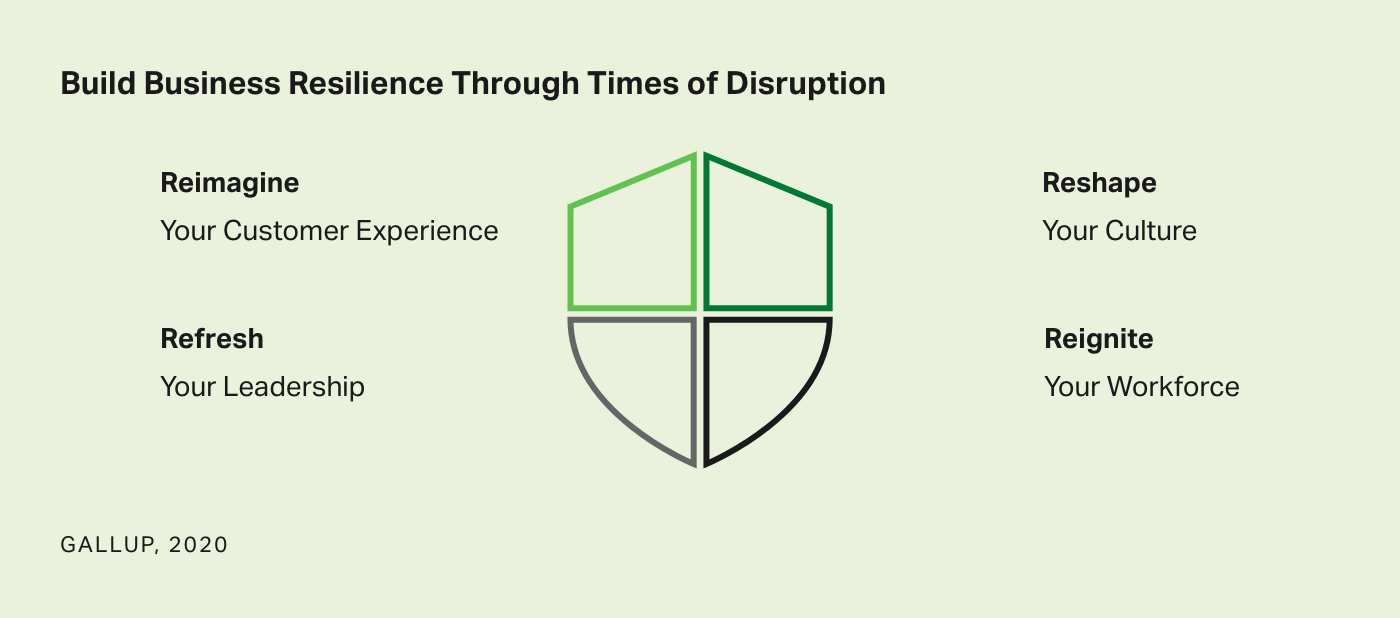Story Highlights
- Leaders can actively build resilience before the next disruption
- Learn four strategies to cultivate a more secure future
If the pandemic has taught business leaders anything, it's this: The question isn't if the next crisis will come, but when.
Because the next change can strike at any moment, leaders and their organizations must be perpetually prepared.
But according to their employees, they're far from ready.
Only 38% of U.S. employees strongly agree that they are confident about their organization's financial future.
Leaders can bridge the confidence gap and build resilience by examining crisis management best practices from world-class organizations. In Gallup's experience, four critical dimensions have emerged as enduring organizational needs and key areas for leaders to focus on.

Custom graphic. Build business resilience through times of disruption by reimagining your customer experience, reshaping your culture, refreshing your leadership and reigniting your workforce.
1. Reimagine your customer experience.
Predicting demand and customer behavior is harder than ever, yet critical to stimulating cash flow. When the stakes are high, companies need to know their customers to drive brand loyalty and long-term profits.
Leaders must display ambidexterity by adapting to consumers' needs without compromising overall brand consistency. This requires an intense focus on the customer experience.
When the stakes are high, companies need to know their customers to drive loyalty and long-term profits.
Company leaders should use advanced analytics to test and optimize their customer journey. By reimagining their customer experience, organizations can stay agile to meet changing needs and cultivate loyalty when it matters the most.
Partner with an objective third party to address the following questions and build a strong customer experience.
- Are customer behaviors or buying patterns shifting?
- Is our culture or "how we do things around here" agile, adaptive and ready for disruption so we can continue to retain our customers?
- What customer intelligence do we need to mine for critical insights?
- Is our customer experience and/or our service delivery optimal in today's environment?
- Do our communications project resilience and genuine customer care?
- What organizational barriers can we eliminate that might prevent our diversification or business model innovation?
- Do we need to create new channels through which to serve our customers?
2. Reshape your workplace culture to ensure it is an ally to disruption.
Most leaders right now have an enormous opportunity to significantly improve performance by reshaping and strengthening their work culture -- any organization's most critical asset.
Only four in 10 U.S. employees strongly agree that the mission or purpose of their company makes them feel their job is important. This is particularly troubling because an organization's culture begins with its purpose.
A weak organizational culture where employees' sense of purpose is lacking leaves organizations more vulnerable to issues like ethical concerns. Plus, it can diminish the organization's brand value and undermine team collaboration and team identity.
In turn, companies lose agility and speed of innovation.
Organizations with strong cultures, on the other hand, are built to withstand disruption.
In strong cultures, leaders and their teams know their purpose and call on it in every decision they make. They more easily align on choices when priorities shift because their core values remain steady. This makes their resulting behaviors more stable even as they react to new circumstances.
Partner with an objective third party to address the following questions and improve company culture.
- What opportunities exist to strengthen and reinforce the organization's purpose, mission and vision?
- What opportunities exist to capitalize on positive brand sentiments gained from demonstrating organizational values with employees and customers?
- What organizational values need to be institutionalized to further localize effective decision-making?
- How can innovation and speed to market accelerate?
- What key leadership messages need to be amplified?
- What cultural values in action need to be in the spotlight?
- Are leaders and managers engaged to drive a culture of performance on their teams?
3. Refresh your leadership development plan and reinforce leadership's core values.
Leaders can't fully predict how a crisis will impact their teams, but they can be prepared to bring their best leadership selves to the table to deal with it. Leaders need to refresh their tactics too.
Gallup research from late March showed that only 38% of U.S. employees have confidence in the leadership of their organization "to successfully manage emerging challenges."
This confidence gap says a lot about the need for leaders to take a step back and evaluate how they are showing up for their organization. Employees need inspiration and direction from their leaders now more than ever.
In times of grueling disruption, to continually inspire their people, leaders must invest in their own development. They first need to know and apply their most dominant strengths. They also must rededicate themselves to core leadership values that guide their daily decisions.
Leaders shouldn't stop with themselves, though. They should prioritize manager development too -- so leaders at all levels are set up for success.
Partner with an objective third party to address the following questions and establish leadership strength and resilience.
- What strengths empower leaders and managers to lead in challenging times? How can leaders gain a deeper understanding of their own natural behaviors to make a difference for the organization?
- How do leaders capitalize on market opportunities to drive innovation?
- How can leaders use a crisis to identify star performers and future leaders?
- How can leaders infuse energy into the organization through role modeling and recognition?
- What can leaders learn from cultural values as they relate to making difficult decisions?
- Is there room to optimize team identity and improve collaboration?
- Are shifts in mindset or leadership style needed to lead the workforce of the future?
In times of grueling disruption, to continually inspire their people, leaders must invest in their own development.
4. Continuously reignite your workforce.
Like other times of significant disruption, COVID-19 has dramatically affected workforces. For instance, many employees have been forced to work remotely and deliver the same products and services with fewer hands on deck. Managers have had to adapt to their employees' changing schedules to accommodate childcare needs and health concerns.
New issues like these present an opportunity to reignite workforce strategies that can help leaders manage uncertainties for the long term. To do so, leaders need to continually prioritize their people and build systems that engage and support their teams and inspire high performance.
Partner with an objective third party to address the following questions and design enduring workforce strategies.
- How do we measure performance through a crisis management lens?
- Where can we reintegrate the workforce with an eye toward diversity and inclusion?
- What strategic talent acquisition opportunities exist for us to take advantage of?
- What key decisions should we revisit for deeper insight?
- What efficiencies discovered during the crisis do we need to institutionalize?
- How can we measure remote workers' performance to optimize the long-term remote work strategy?
- Do we have the right roles and structure for immediate and future business needs?
Disruption can leave leaders in a reactive state as they tackle high-priority problems. But the best leaders don't just resolve concerns -- they take advantage of crises by supporting peak agility and resilience.
To this end, they are continually reimagining their customer experience, improving workplace culture, refreshing their leadership development and reigniting their workforce strategies.
When leaders prioritize these dimensions of business performance, they stay focused on what really matters and inspire their teams to do the same -- even when everything changes.
Create a secure future for your people and business:
- Download Gallup's perspective paper on building a strong company culture.
- Learn how we can help you build a resilient business by delivering what customers want.
- Explore our workplace learning programs that help leaders create alignment and get results.





